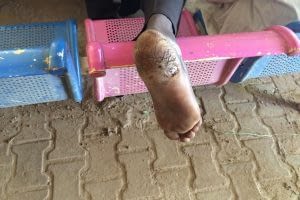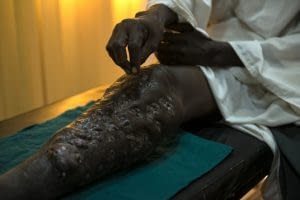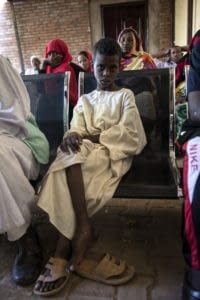How can a simple thorn prick be so devastating?

Every Monday morning at a clinic on the dusty outskirts of the Sudanese capital Khartoum, sufferers of one of the world’s most neglected diseases flock to the only place in the world that can offer them specialized care and treatment. Patients stream through the gates limping, on crutches, pushed by worried relatives on rusty wheelchairs or carried. Most have bandaged legs, many are amputees.
They have come from surrounding villages, from far-away regions – often from areas in the country consumed by conflict and poverty. Some patients sleep at the mosque across the street to arrive early. They are all coming to this place, known as the Mycetoma Research Centre, because they suffer from a chronic infection known as mycetoma. For these patients, the Centre’s founder Dr Ahmed Fahal and his staff are their only hope.
Most were probably infected through a simple thorn prick.
The disease
Devastating, destructive and deeply neglected

The acacia trees dotting the dry Sudanese landscape have large thorns, strong enough to puncture the skin. The thorns probably come in contact with the causative agent of mycetoma when they fall off the tree and land in the soil. Transmission can occur when people walking barefoot step on a thorn. Other minor injuries to the hand or foot can also result in infection.
Mycetoma affects the poorest populations in the most remote areas, both men and women. Those that work or travel barefoot are the most at risk: field labourers and herders.
There are two forms of mycetoma, a bacterial form (actinomycetoma), which is prevalent in Central and South America, and a fungal form (eumycetoma), which is mainly endemic in Africa. Treatment for the bacterial form is effective – simple antibiotics are used with cure rates of up to 90%. But for the fungal version of the disease – the focus of this website – current treatments are extremely long, toxic, ineffective, and expensive.
Mycetoma is endemic in tropical and subtropical areas of what is coined the ‘mycetoma belt’, which includes Venezuela, Chad, Ethiopia, India, Mauritania, Mexico, Senegal, Somalia, Sudan, and Yemen. Most countries are located between 30°N and 15°S. Sudan is without doubt the epicenter of the disease.
Thanks in part to more media attention – in particular a three-part series on mycetoma by the website Global Health NOW – and increasing recognition by the World Health Organization (WHO), mycetoma is slowly creeping its way into the global consciousness.
“Mycetoma patients are unique patients. Our big challenge now is to offer them a safe and affordable treatment.”
Dr Ahmed Fahal
Fungal mycetoma starts with a lesion
After the causative agent of mycetoma enters the body, the disease starts as a small lump under the skin with painless swelling. The photo above is of a boy’s foot, about one year after he stepped on an acacia thorn.


The infection spreads
More lesions can emerge after several years. They eventually discharge pus and spores. If caught early, the lesion may be removed surgically. Otherwise it will continue spreading to the limbs, resulting in their destruction and severe deformity.
Final stages
Without treatment or amputation, the infection can spread to other limbs, the torso and the rest of the body. It can be fatal. Secondary bacterial infections are common. At this point, even after amputations the disease can still spread.

Because it is such a neglected disease, there are major knowledge gaps about mycetoma, including about its transmission, prevalence, route of infection, and susceptibility. The disease was only recently added to the WHO’s official list of 18 ‘neglected tropical diseases,’ after years of advocacy by mycetoma researchers and doctors to get recognition.
A brief history of this neglect
Amasi
The face of mycetoma

“I can’t touch water so I can’t bathe – I can’t do my daily activities. I’ve been late to school. I have no crutches and I don’t own a wheelchair, which I need to borrow. It is very difficult to walk.”
Amasi, 18 years old
Amasi is 18 years old and has been infected for over a year. She lives in the village of Shadida Agabna, in Gezira State, a region south of Khartoum that is heavily affected by mycetoma.

According to the Mycetoma Research Centre, about 20-25% of mycetoma patients are children. They often drop out of school and are unable to be among their peers. Stigma and shame force them into a life in the shadows.

In Amasi’s case her peers lend a hand, push her around the village in a borrowed wheelchair, and contribute collectively for her care.
All of this because of a simple thorn prick.
The perils of care
Amputations or toxic, ineffective and expensive drugs: What patients have today

In Amasi’s village, about 4% of the population is infected with mycetoma. To the right, village elder Yousid Gaffer holds up a list of the 12 people who have had amputations – out of a village of about 700 people. Patients need to travel long distances to the nearest city Wad Medani, or further to Khartoum for surgery.
Due to the lack of safe and effective treatments for the fungal version of mycetoma, amputation is often the best (and only) chance patients have.

What treatment options?
For the bacterial form of mycetoma, antibiotics (amikacin and co-trimoxazole) are given over a number of weeks and have cure rates of up to 90%. Surgery is not often needed. On the other hand, treatment for the fungal version requires the prolonged use of antifungal drugs with significantly lower cure rates.
Ketoconazole and itraconazole are the antifungal agents that are currently in use. Treatment courses can last up to a year, with repeated courses – often to no avail. These treatments have an efficacy rate of around 25-35% with a high chance of recurrence. Both have side effects. The US Food and Drug Administration (FDA) has restricted the use of ketoconazole because of concern over liver toxicity.
Another major barrier is price.
The unbearable price of treatments
Judah Mohammed Bellah is 10 years old and had travelled with his father to the Mycetoma Research Centre from the Sennar region, about six hours away. They were staying with relatives for two weeks while being treated by Dr Fahal’s staff.
A few years ago Judah was running along the river Nile and stepped on a thorn. He was infected. When his lesion became swollen, he could no longer go to school along with his seven siblings. Judah’s father stopped working to take care of him and eventually hired a rickshaw driver to take him to school.
Judah just had surgery in the city of Wad Medani and was taking ketoconazole. His father took an extra job to pay for the costs:
Treatment and rickshaw: 130 dollars a month
Dad’s monthly salary: 320 dollars a month
Almost half of Judah’s father’s monthly salary (working two jobs) go to his son’s treatment and care.

“The Prof”
One man’s fight against mycetoma

Thousands of patients flock to the Mycetoma Research Centre in Khartoum because its founder Dr Ahmed Fahal is their only hope. Because mycetoma is so desperately neglected, basic research on the disease and data is lacking. Most of what we know is through Dr Fahal’s eyes and his experiences at the Centre since it opened its doors in 1991.
Known as the “Prof” by his staff, Dr Fahal is a prominent Sudanese surgeon. Dr Fahal established the Mycetoma Research Centreby using his own network of personal contacts to generate funds for the project. Today, the centre is recognized globally as a world leader and authoritative source of advice on mycetoma management and research.

To date, the Mycetoma Research Centre has treated over 7,200 patients and operates almost exclusively on the small amounts of funding that Dr Fahal has been personally able to generate. On any given day, as many as 150 patients wait outside of the MRC for check-up appointments. Patients have travelled from villages from all over Sudan but Dr Fahal has seen patients from a number of countries, including Chad and Gulf countries.
Alsadik’s story
Nineteen years ago, while playing football on the school field, Alsadik Mohamed Musa Omer was infected with mycetoma when he pricked his foot on a thorn.
After about one year, the wound had grown into a massive sore. Alsadik was operated on for the first time. However, two years later, the disease was back and more severe than it had been before. Frustrated, he visited the Mycetoma Research Centre. By this time, the infection was at a very advanced stage. The experts at the MRC tried out a number of treatments and a total of seven surgeries, but the disease kept recurring.
“I was in excruciating pain. I had to use a lot of pain killers just to be able to walk from one point to another. At some point, I got tired and decided to have my leg amputated.“
It took him two months to convince the doctors at the MRC to amputate his leg. “All treatments were not working. The amputation has given me some peace, even though I know I am not completely cured,” he explains.
Alsadik dropped out of school after his first operation and had to stop working after his last operation. His lack of income has been difficult for his wife and five children. He has to depend on well-wishers to access treatment.

A new hope?
Increased attention, potential new drugs, renewed commitment

There have been a number of promising developments in the response to mycetoma, offering a new hope for mycetoma patients.
Landmark clinical trials
The Drugs for Neglected Diseases initiative (DNDi) has recently launched a clinical trial for a promising antifungal treatment for mycetoma, in what will be the first ever double-blind clinical study for the disease. Fosravuconazole, an azole-class antifungal drug discovered by the Japanese pharmaceutical company Eisai, has shown to have strong antifungal activities against mycetoma in the laboratory.
Fosravuconazole will be investigated in a randomized controlled trial to study the efficacy of the drug compared to an existing therapy in moderate eumycetoma cases. This study is scheduled to start in 2016, and will be conducted by DNDi in collaboration with the Mycetoma Research Center.
Global advocacy
The abject neglect behind Mycetoma has inspired a new generation of young-access-to-medicine activists, desperate to put the disease on the map. Two University of Toronto students, Annie Liang and Simran Dhunna (pictured), were frustrated with the lack of attention received by mycetoma at the World Health Assembly and nominated the disease for 2015 Global Health Untold Stories Contest. They won, which led to Global Health NOW’s series on the disease.
At the World Health Assembly in 2016, Mycetoma finally got the attention it deserves on a global stage. During the 69th World Health Assembly mycetoma was added to WHO’s official list of ‘neglected tropical diseases,’ an important step in addressing the suffering of patients. Mycetoma becomes the 18th disease to be included on this list. Please read science reporter Amy Maxmen’s account on Global Health NOW about how the disease was added.
Images:
Abraham Ali
Neil Brandvold








